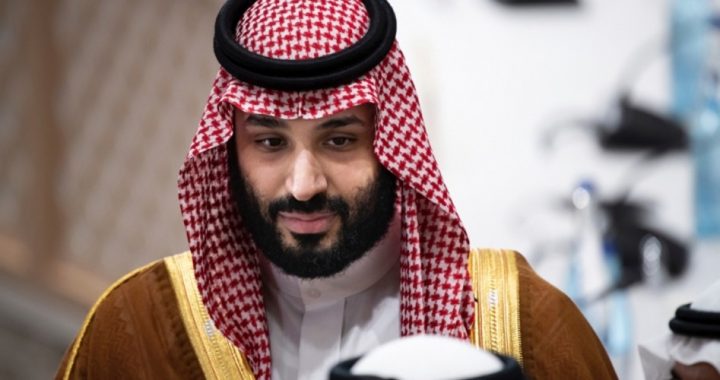
Podcast: Play in new window | Download ()
Subscribe: Android | RSS | More
Saudi Arabia’s Crown Prince Mohammed bin Salman (shown), known as MBS, just relieved his energy minister, Khalid al-Falih, of his duties concerning the Initial Public Offering (IPO) of his country’s primary asset, ARAMCO (officially, the Saudi Arabian Oil Company). Plans for that offering, first announced in 2018, were to raise $100 billion for the country’s sovereign wealth fund so it could invest the funds to diversify the economy away from its dependence upon oil revenues and bring it into the 21st century.
Plans were delayed for several reasons. First, MBS needed to consolidate his power. Taking control in 2017, he announced a program to fight corruption in the government, leading to the arrest and murder of a number of high-ranking officials while confiscating the wealth of others in exchange for their lives. He also allgedly ordered the murder of dissident journalist Jamal Khashoggi, which temporarily tarnished his public persona and delayed further his plans for the IPO.
It didn’t help any that U.S. frackers, oblivious to the plans of the crown prince, continued to produce above expectations, putting pressure on world oil prices in the process.
Energy Minister al-Falih counseled a wait-and-see approach, urging MBS and the OPEC cartel to cut production further in the hopes that world crude oil prices would rise to at least $80 a barrel. Outside auditors estimate that $80 a barrel is the price the kingdom needs to balance its welfare-state budget.
His strategy nearly succeeded. Brent crude oil prices peaked at $85 a barrel briefly last October before plummeting to $50 two months later. Since then, world crude oil prices have languished and curently trade (as of Tuesday) under $60.
The crown prince’s government was running out of money. It had squeezed ARAMCO for a $20 billion special dividend to help close the budget deficit. It sold $12 billion of government bonds for the first time in the country’s history last spring. But the pressure is on and time is running out.
Replacing el-Falih with Yasir al-Rumayyan spoke volumes. Al-Rumayyan is head of the country’s Public Investment Fund, the country’s primary sovereign-wealth fund, which is expected to be the recipient of the proceeds from the IPO. He will then make the decisions on where that money will be spent in order to diversity the kingdom’s economy into real estate, tourism, manufacturing, entertainment industries, and the like. He knows little about the oil business but a lot about financing, which is why he now runs the IPO show for the prince. It also helps that he is a close ally (and survivor of the inquisition) of the crown prince.
When international banking firm Morgan Stanley recently predicted that world crude prices over the next two years weren’t likely to come anywhere close to the $80 the prince needs, the die was cast: Al-Falih was removed and al-Rumayyan took over.
The plans are still in flux but becoming clearer by the day. Deciding that now is the time — not the best time but better than waiting longer — to move ahead with the IPO, the new director is considering doing the offering in two pieces: one offering through the country’s own stock exchange (to take the temperature of bond investors and see how they respond) before offering the balance through a larger exchange that can attract more international sovereign debt investors, probably the Tokyo Stock Exchange. This makes political sense, as Saudi Arabia supplies about a third of Japan’s crude oil demands and such a deal would further cement that relationship.
As the Wall Street Journal noted, “For Aramco observers, the change [replacement of al-Falih with al-Rumayyan] signaled a new sense of urgency in moving ahead with the public listing.”
The crown prince is likely to be sorely disappointed when the results of the sale of two offerings of a small slice of his country’s primary asset are in. He needs a valuation of Aramco at $2 trillion. The sale of five percent of it would generate the $100 billion he has been promising. He’s not likely to get either. Bankers looking at the deal are privately estimating that Aramco is worth between $1.2 trillion and $1.5 trillion. The sale of five percent of it would generate between $60 billion and $75 billion in net proceeds. Given his government’s budget shortfall, it’s more than likely that most of the money would go to shore up its finances, leaving precious little left for al-Rumayyan to invest for the country’s future.
Thanks to the continuing revolution taking place in the U.S. oil patch (and a slowing global economy), Saudi Arabia’s crown prince is likely to fall far short of completing the grandiose plans he has for his country.
Photo: AP Images
An Ivy League graduate and former investment advisor, Bob is a regular contributor to The New American, writing primarily on economics and politics. He can be reached at [email protected].
Related article:
Saudi Arabia Once More Delays Plans to Sell Part of Its Oil Company



